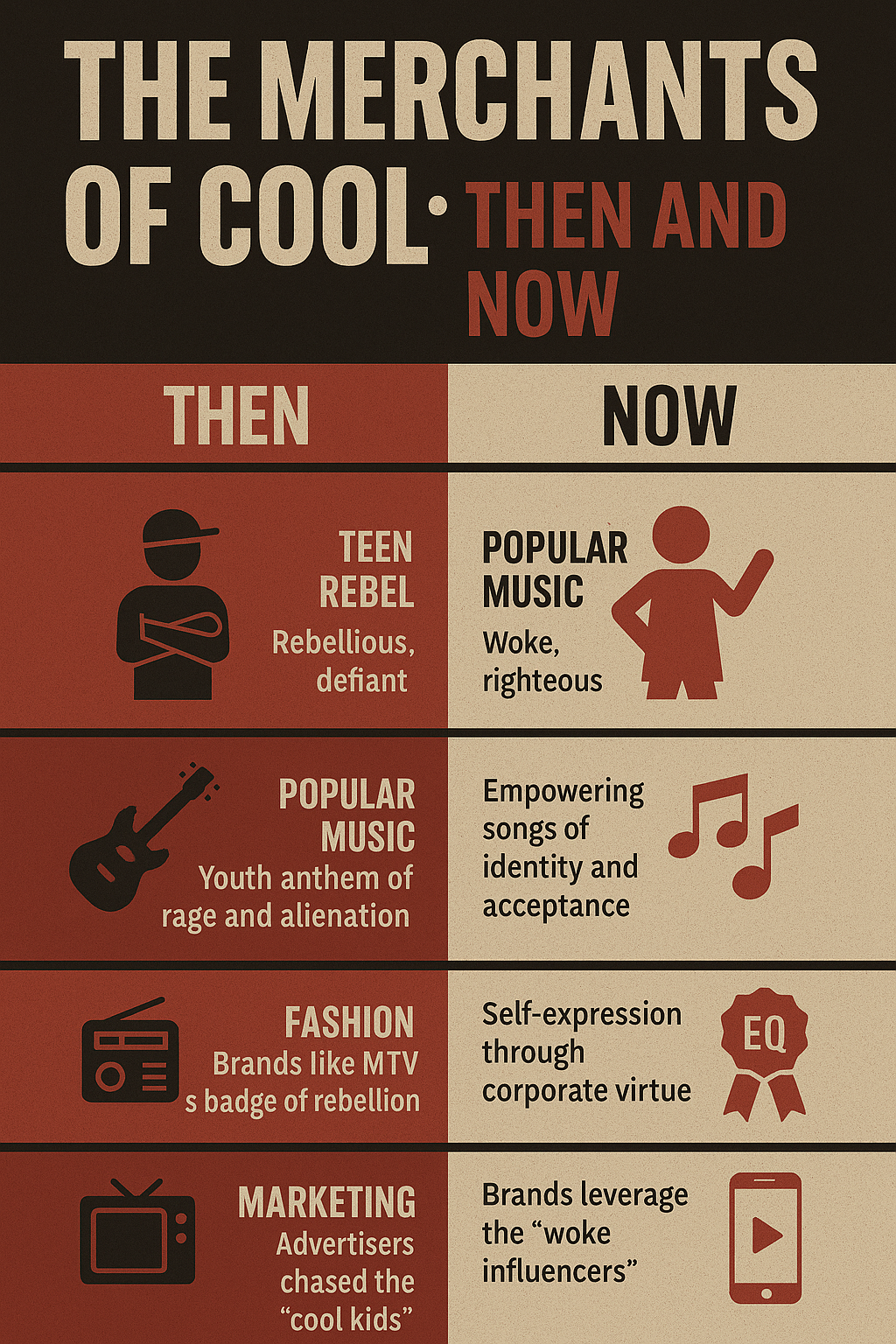How Advertising Evolved from Coolhunting to Behavioral Control in the Algorithm Age
Introduction
In the early 2000s, the documentary The Merchants of Cool exposed how corporations infiltrated youth culture to sell products back to the very teenagers they studied. Cool wasn’t just observed—it was harvested, repackaged, and resold.
But in the two decades since, advertising has mutated into something far more invasive, predictive, and powerful. No longer satisfied with influencing culture, modern advertisers now shape identity, behavior, and even emotion—in real time.
This article examines how advertising has evolved since the 1990s, how it manipulates today’s hyper-connected consumers, and what it reveals about the deeper transformation of society—from freedom to control, from culture to code.
The Roots: Advertising in the 1990s
The 1990s were a golden age of youth marketing. Big brands treated teens not just as a market segment, but as an anthropological mystery to decode and exploit.
- Coolhunting: Corporations paid “cultural spies” to identify underground trends.
- Repackaging rebellion: Edginess was monetized. Brands like MTV, Sprite, and Abercrombie co-opted teenage defiance to sell conformity.
- TV was king: Marketing was still top-down. Ads pushed a message and hoped consumers would bite.
- “Anti-authority” became the sales pitch: Ironically, this rebellion was pre-approved by the very institutions the ads pretended to defy.
The Merchants of Cool warned us that youth culture had become a commercial feedback loop. But no one imagined just how fast and deep that loop would go.
From Culture Watching to Culture Engineering
A. The Rise of Surveillance Capitalism
In the 2000s, marketing evolved from watching trends to predicting behavior. As the internet matured, so did the tools of influence:
- Cookies, trackers, and data brokers turned every click, pause, and scroll into a marketing data point.
- Social media became the new arena—but with a twist: the users were both the audience and the actors.
“If you’re not paying for the product, you are the product.”
— Silicon Valley maxim
Unlike the 90s, where advertisers asked what you wanted, today’s systems decide what you’ll want next—before you know.
B. From Broadcasting to Behavioral Targeting
- THEN: “Prime time” TV slots, magazine ads, and radio jingles.
- NOW: Real-time psychographic targeting across platforms (Instagram, TikTok, YouTube, Spotify, even smart fridges).
AI tracks:
- What you watch
- How long you look
- What emotional tone your voice carries
- What your wearable tech says about your stress level
Result? Advertising no longer sells a product. It nudges behavior.
The Neurological Hijacking of Cool
Modern advertising isn’t just psychological. It’s neurological.
Drawing on behavioral science, addiction research, and dopamine feedback loops, today’s platforms:
- Trigger micro-doses of reward through infinite scroll, swipe mechanics, and push notifications.
- Embed ads within the reward loop itself (native ads, influencer plugs, product placements).
- Use A/B testing millions of times per second to optimize what keeps your attention—outrage, desire, envy, tribalism.
This is not just manipulation. It’s neural engineering.
Where The Merchants of Cool exposed cultural manipulation, today’s merchants control your chemical response system.
From Consumers to Human Billboards
Social media didn’t just change advertising—it weaponized the consumer:
- Influencers are the new ad agencies.
- Teens are no longer being sold to—they’re selling themselves.
- Every selfie, haul video, “what I eat in a day” post is a form of unpaid advertising for a brand.
Even anti-consumerism gets monetized: “minimalism,” “authenticity,” and “wellness” are brandable aesthetics sold on Instagram.
Selling Identity, Not Just Products
In the 90s, advertisers sold “cool.”
In the 2020s, they sell who you are.
| Brand | Identity Sold |
|---|---|
| Nike | Empowerment & grit |
| Apple | Creativity & status |
| Patagonia | Environmental virtue |
| Ben & Jerry’s | Activism |
| Red Bull | Risk-taking adrenaline |
Modern marketing doesn’t ask, “Do you want this?”
It asks: “Who do you want to be?”
Then it answers for you—if you let it.
From Manipulation to Control
Today’s marketing systems go beyond selling. They’re designed to shape society:
- Echo Chambers: Algorithmic advertising reinforces bias and ideological bubbles.
- Cancel Culture: Brands now weaponize outrage to manipulate social behavior.
- Surveillance Tech: Facial recognition, emotion detection, and wearable integration blend advertising with authoritarian potential.
“The line between commerce, propaganda, and control has blurred.”
And in a world of digital dopamine, the merchants of cool have become merchants of compliance.
From Teen Culture to Human Programming
This evolution reflects major patterns:
- Tytler’s Cycle: From abundance to dependence, advertising accelerates the slide into apathy and bondage.
- Kohlberg’s Stage 2–3 Morality: Ad campaigns exploit self-interest and peer pressure—trapping consumers in immature moral stages.
- Dopamine Nation: Pleasure-pain imbalance fueled by digital addiction.
- Propaganda & Neural Pair Bonding: Marketing replaces human belonging with parasocial loyalty to brands.
- Shadow Projection & Identity: Brands give consumers a ready-made persona to avoid facing the deeper self.
Conclusion: Can We Escape the Loop?
We’ve moved from coolhunting to neurohacking.
From selling culture to controlling behavior.
From advertising products to programming identities.
But awareness is power.
We must:
- Teach media literacy to our children and ourselves.
- Expose and resist the false self sold by marketers.
- Disconnect from addictive platforms and reclaim presence.
- Choose meaning over manipulation—agency over autopilot.
“To rebel today is to resist programming.”
— A modern reinterpretation of cool







